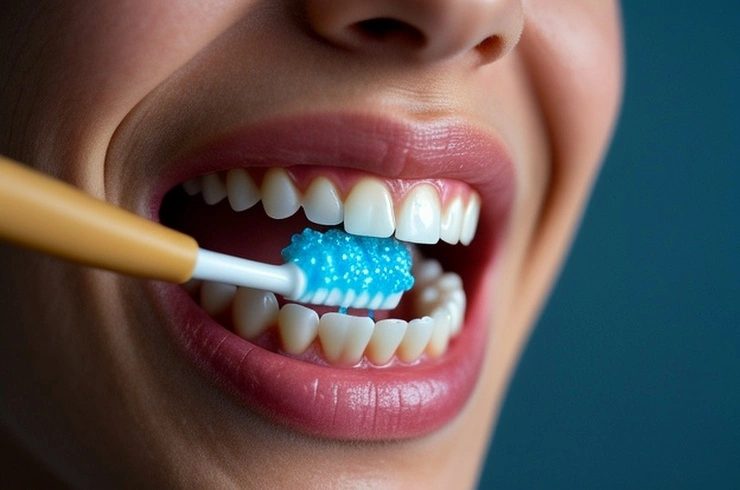
Our teeth are constantly engaged in a two-way mineral exchange: demineralization and remineralization. Demineralization occurs when acids, produced by plaque bacteria and sugars, strip minerals from tooth enamel. Conversely, remineralization is the process where minerals like fluoride, calcium, and phosphate are redeposited onto the enamel, strengthening it. When demineralization outpaces remineralization, tooth decay sets in.
Fluoride plays a crucial role in preventing this decay. It not only makes teeth more resilient to acid attacks but also aids in reversing early-stage decay. In children under six, fluoride integrates into developing permanent teeth, bolstering their resistance to acid. For both children and adults, fluoride accelerates remineralization and inhibits acid production in erupted teeth.
Where Can You Find Fluoride?
Fluoride is naturally present in many foods and water sources. Additionally, it's a key ingredient in dental products:
Toothpastes and Mouth Rinses: Over-the-counter fluoride mouth rinses offer lower strengths, while stronger concentrations are available by prescription.
Professional Applications: Dentists can apply high-concentration fluoride in gels, foams, or varnishes during office visits. Varnishes are painted on, foams are applied via a mouthguard, and gels can be painted or used with a mouthguard.
Supplements: Liquid and tablet fluoride supplements require a prescription from a dentist, pediatrician, or family doctor.
When Is Fluoride Most Important?
While fluoride exposure is vital for infants and children aged 6 months to 16 years, when primary and permanent teeth emerge, adults also benefit significantly. Modern research emphasizes the importance of topical fluoride from toothpastes, mouth rinses, and professional treatments in fighting decay and strengthening teeth.
Certain individuals face a heightened risk of tooth decay and can especially benefit from additional fluoride:
Dry Mouth Conditions (Xerostomia): Caused by diseases (e.g., Sjögren's syndrome), medications (e.g., allergy, anxiety, high blood pressure drugs), or radiation treatment, dry mouth reduces saliva, making it harder to clear food particles and neutralize acids.
Gum Disease (Periodontitis): This condition exposes more of the tooth and roots to bacteria, increasing decay risk.
Frequent Cavities: If you regularly experience cavities, supplemental fluoride might be beneficial.
Crowns, Bridges, or Braces: These dental appliances can create areas susceptible to decay where they meet the tooth structure or around orthodontic brackets.
Always consult your dentist to determine if additional fluoride is right for you.
Understanding Fluoride Safety
Fluoride is safe and effective when used as directed. However, high doses can be hazardous, with the toxic level varying by individual weight. Therefore, it's crucial for parents to supervise children's use of fluoride products and keep them out of reach, especially for children under six.
Excessive fluoride intake during tooth formation (typically under age six) can lead to fluorosis, which manifests as enamel defects ranging from subtle white flecks to noticeable brown discoloration. This is often linked to naturally occurring fluoride in sources like well water. If you use well water and are unsure of its mineral content, have it tested. While fluorosis stains are resistant to normal hygiene, dentists can often lighten or remove them professionally. It's important to remember that reaching hazardous fluoride levels through typical home products is very difficult. If you have concerns about fluoride intake, speak with your dentist, pediatrician, or family doctor.
Key Fluoride Reminders:
Store fluoride supplements away from young children.
Avoid flavored toothpastes for children, as they may encourage swallowing.
For children, use only a pea-sized amount of fluoridated toothpaste.
Bottled Water and Fluoride
While no scientific studies directly link bottled water consumption to increased tooth decay, the American Dental Association (ADA) suggests that those who primarily drink bottled water might miss out on the decay-preventing benefits of optimally fluoridated community water supplies. Most bottled waters do not contain optimal fluoride levels (0.7 to 1.2 parts per million, typical in fluoridated public water). Check bottle labels or contact the manufacturer for fluoride content.
Home Water Treatment Systems and Fluoride
The impact of home water treatment systems on fluoride levels varies:
Steam Distillation Systems: Remove 100% of fluoride.
Reverse Osmosis Systems: Remove 65% to 95% of fluoride.
Water Softeners and Charcoal/Carbon Filters: Generally do not remove fluoride, with the exception of some activated carbon filters containing activated alumina, which can remove over 80%.
If you use a home water treatment system, have your water tested annually to assess fluoride levels. Testing services are available through local and state public health departments and private laboratories. Also, review the product information provided by your system's manufacturer.
Finding Your Tap Water's Fluoride Level
To determine the fluoride concentration in your tap water, contact your local dentist, state or local health department, or your local water supplier. Water bill statements or the "local government" section of your phone book should provide contact details for your water supplier.
Currently, approximately 62% of the U.S. population served by public water supplies has access to adequate fluoride levels, and 43 of the 50 largest U.S. cities utilize water fluoridation systems.
Pro Tip
The content of the article is shared by netizens, please carefully identify it